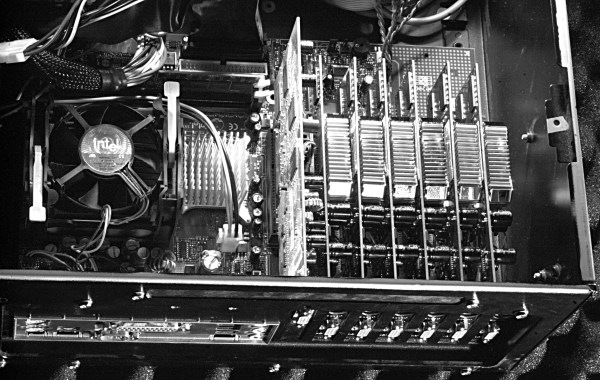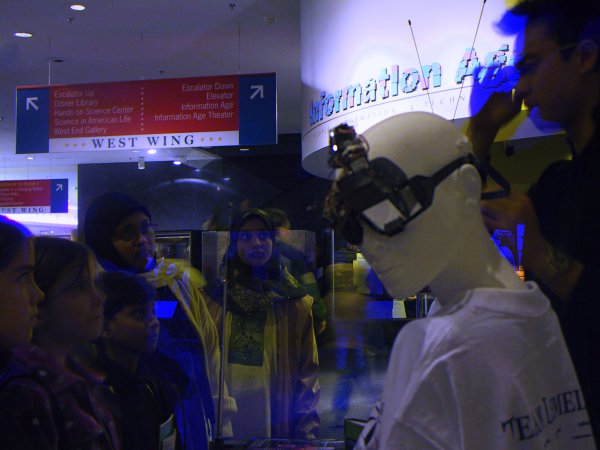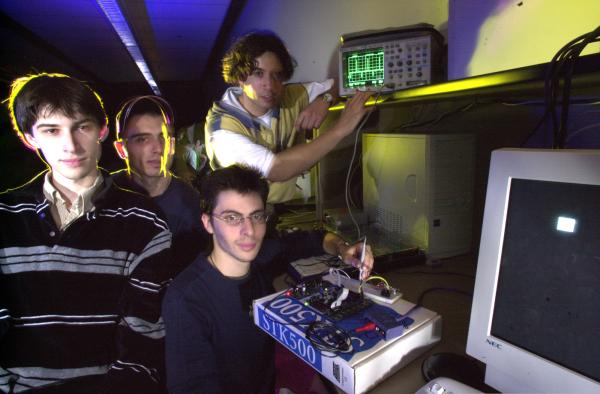


With the advent of digital photography, cameras have become pretty much alike. It doesn't much matter whether you shoot with Nikon or Canon, or some other brand. Sure, I'll be the first to admit that a comparametric analysis could prove mathematically that there is a difference between one brand and another, but these differences are very subtle, and pretty much imperceptible.
And because modern cameras are so easy to use, anybody can be a photographer. Just shoot first and shoot later: shoot, shoot, shoot, and keep watching the little TV or electronic viewfinder on the camera. With such instant feedback, anybody can learn it.
So what value can a photographer add?
Right now, the best all-around light source is the Metz Mecablitz, either the 70MZ or the 60CT-1.
It's ideal for modern wearable or hand-held digital cameras.
Here is a picture of a new computer architecture for digital photography
that my PhD student James Fung and I invented.

This picture was taken with one Metz 70MZ and processed using our comparametric dynamic range enhancer.
The high light output of the Metz ushers in a new era of high dynamic range imaging.
This picture was taken quickly and spontaneously by finding a scrap of black foam to put on the floor, setting the computer down on it, and shooting quickly and easily.
The nice thing about digital photography is you don't need big heavy modeling lights.
You just shoot what you see, and move the light (Metz) around until you like what you get.
Because the light (lamp) is light (not heavy) it's easy to move around, and this affords a higher degree of spontaneity than you can get with studio flash systems.
When my work was being shown at the Smithsonian Institute I needed a quick and easy way to document the work in the National Museum of American History exhibit space. This is a huge exhibit space with lots of people, and we needed something small that my students could use to capture images with. So we choose the Metz 70MZ because it's versatile (adjustable zoom) and easy to carry in carry-on (studio lights would have had to have been put in checked luggage and would therefore have likely been lost, stolen, or smashed up by Err Canada).

(double exposure, yellow/blue, made with one Metz 70MZ; double
exposure shows the motion
of audience members moving through the exhibit space, while keeping
the eyewear of the exhibit in solid view.)
The nice thing about the Metz is it's small enough to carry-on most flights, and powerful enough to light up a huge exhibit space and even do some "wrong-way" shooting. It also liberates us from the need to find electrical outlets. Such spontaneous shooting didn't get in the way of anyone attending the exhibit.
The Metz is small enough you can carry it in a briefcase. Sometimes when I see something I want to capture, I just quickly shoot it. For example, the students in my lab had a really cool demo, and I thought it would be nice to take a picture of them with the demo:

(Multiple exposure picture quickly taken with one Metz 70MZ,
using the comparametric imaging programs and toolkit. This picture was
taken quickly (in just 2 or 3 minutes) without wasting time setting up
studio lights.)
There was some construction next door; while I was walking by I took a quick snapshot using the Metz 70MZ.
It's nice to be able to take spontaneous pictures that are well lit!
Christmas Eve we decided to celebrate the arrival of the Metz by organizing an event to promote the use of bright lights. Here is the material as it appeared in the original Press Release for the World Wide Web:
Worldwide Flash Mob: tonight, 2003 December 24th.
Anywhere and everywhere, you can participate by creating a flash of light. Find a Metz Mecablitz, or just use your on-camera flash, and take a picture at 23:59:58, 59, or, depending on the slowness of your shutter, a fraction of a second just before midnight.
Where ever you are, point a camera flash up into the night sky, and LET THERE BE LIGHT at exactly midnight.
"in thy dark streets shineth the everlasting light;"
--Lewis H. Redner, 1830-1908
 This image made possible by the Nikon D2H and
the Metz Mecablitz.
This image made possible by the Nikon D2H and
the Metz Mecablitz.
 This image made possible by the Nikon D2H and
the Metz Mecablitz.
This image made possible by the Nikon D2H and
the Metz Mecablitz.
 This image made possible by the Nikon D2H and
the Metz Mecablitz.
This image made possible by the Nikon D2H and
the Metz Mecablitz.
 This image made possible by the Nikon D2H and
the Metz Mecablitz.
This image made possible by the Nikon D2H and
the Metz Mecablitz.
 This image made possible by the Nikon D2H and
the Metz Mecablitz.
This image made possible by the Nikon D2H and
the Metz Mecablitz.